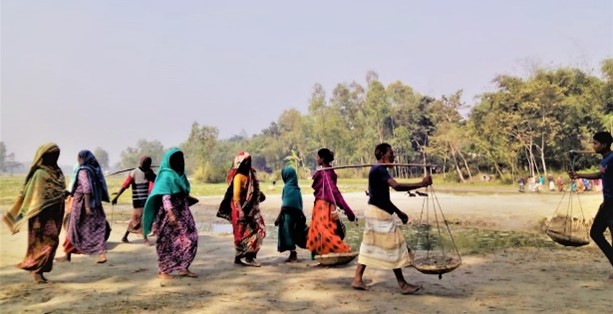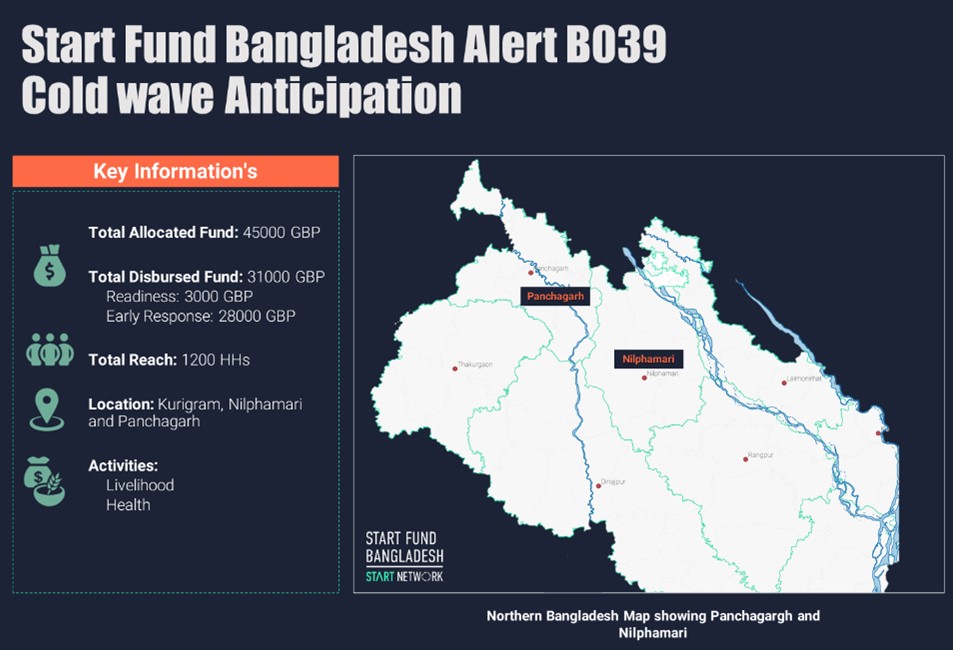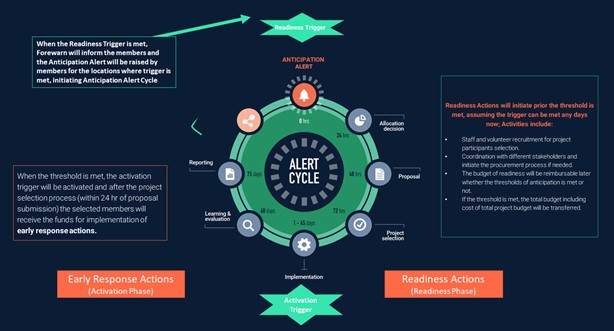Categories
Anticipatory action for cold waves in Bangladesh

Cold waves regularly hit northern Bangladesh, occurring in January and February approximately every two years. These extreme weather events often have severe impacts, hindering the livelihoods of the most vulnerable people. For example, fog and winter rain can reduce cash crop yields, and thus the income people earn from these. Cold waves can also have significant health impacts, contributing to acute respiratory infection (ARI), fever, pneumonia, asthma, coughs and skin diseases, especially among the elderly and children.
But cold waves are an overlooked disaster, with few humanitarian agencies acting to tackle these impacts. Consultations with members of the Start Fund Bangladesh and FOREWARN Bangladesh indicated that there is much more humanitarian agencies could do to reduce the vulnerability of those most at risk – including acting ahead of a forecast cold wave. To achieve this, the Start Fund’s developed ‘Anticipatory alert B039: cold wave anticipation in Bangladesh’ (Figure 1).

Trigger monitoring and threshold development
To establish the triggers that would activate this alert, FOREWARN Bangladesh analysed six years of cold wave data. This identified 11 districts vulnerable to cold waves and established that 20 per cent of cold wave events occur during the period 21-25 January. This study also clarified the potential impacts of cold waves on people, while a further vulnerability and impact analysis established location-specific vulnerability and needs caused by cold waves.
Through this research, and in consultation with cold wave experts – meteorologists, climate experts, and researchers from the Bangladesh Meteorological Department and FOREWARN – temperature was identified as the most effective trigger for forecasting cold waves, with a lead time of seven days for readiness actions, and five days for activating early response actions.
Three threshold levels were established for activating early response actions in anticipation of a cold wave.
- If the 7-day temperature forecast using the European Centre for Medium-Range Weather Forecasts (ECMWF) and the Weather Research and Forecasting (WRF) models show the minimum temperature will go below 8˚C and persist for at least two days in any district.
- If the 7-day temperature forecast (from ECMWF and WRF) shows the minimum temperature equal to or below 12˚C, and a difference between maximum and minimum temperatures of 6˚C.
- If the 7-day forecast temperature (from ECMWF and WRF) shows the minimum temperature is 6˚C or below at a particular location in any district.
FOREWARN Bangladesh established a system in which temperature data from local meteorological observation stations are used in the ECMWF and WRF models, to create localized forecasts for the most risk-prone districts (as identified in their study). Since December 2021, the FOREWARN Bangladesh team has been delivering these localized 7-day forecasts to Start Fund Bangladesh members to monitor the triggers and thresholds for cold waves.
A new approach to activation and actions
Once reached, these triggers will initiate the anticipation alert cycle (Figure 2). This is a new approach to acting ahead of a natural hazard, one that combines the FOREWARN trigger monitoring cycle and the Start Fund alert cycle.

Combining the two approaches was required because the Start Fund cycle does not have a trigger-based activation system. It usually disburses funds for an anticipated disaster using alerts based on secondary data and information about a hazard. Meanwhile FOREWARN only develops and monitors triggers for anticipatory actions; it does not outline actions to be taken.
This was the first time that FOREWARN developed a trigger-monitoring system to support a Start Fund anticipatory alert of Start Fund. As this approach was different to the standard Start Fund alert cycle, the Start Fund Bangladesh secretariat decided that it should first be piloted as a new approach to anticipatory action. Operational guidelines were created to explain this new procedure, and it was explained to member agencies to provide them with a better understanding. This induction, as well as the selection of beneficiaries, staffing and other procedures, were all part of readiness actions.
Disbursement of funds
The allocated funds were disbursed to agencies in two tranches: one for readiness actions, and a second for early response actions, based on activation of the separate lead time for these actions (Figure 3). Disbursing funds in two tranches helped to ensure that if the activation trigger was not met, agencies would not implement the early response actions.

Piloting this approach
Since December 2021, Start Fund Bangladesh members have been receiving 7-day temperature forecasts from FOREWARN Bangladesh. The activation threshold level was met in Panchagarh district on 23 January 2022, and in Nilphamari district on 26 January, and ESDO, the local agency responsible for implementing the agreed actions in these districts, was notified.
Through the agreed actions, 1,200 households received a ‘cash package’ worth 2,450 Bangladeshi Taka (approximately 26 Euros) to cover seven days of income. Providing cash allows beneficiaries to use it for their individual needs, whether securing food or buying emergency medicines; this helps to prevent people from adopting negative coping mechanisms, such as taking out high-interest loans or missing meals. Beneficiaries also received masks to mitigate risks to their health and livelihoods from the cold wave. It took two days for the delegated agencies to reach the communities and distribute this aid.
Challenges and next steps
Monitoring the implementation of readiness and early response actions ahead of this cold wave identified some important lessons.
- For the pilot project, only temperature was considered when establishing triggers and thresholds for cold waves. However, additional conditions - such as wind speed and direction, rainfall, population density, water bodies and fog – should also be considered to determine how significant the impacts will be.
- Not all at-risk districts have meteorological observation stations. This limited the number of locations that could be properly monitored to provide localized forecast information, which in turn limits the anticipatory actions that can be taken in vulnerable locations.
- There is a need for more advocacy around anticipatory action in Bangladesh, especially for small-scale localized disasters that affect highly vulnerable communities.
This blog was written by Marwa Tasnim, an analyst at the Start Fund Bangladesh. The Start Network will be holding a community meeting to discuss this subject on 9 March 2022.

